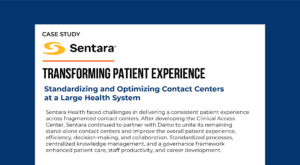How to Accelerate Digital Transformation in 2022: Salient points to remember

The path to healthcare transformation depends on how strong a relationship you build with your consumers, and that today depends on how digitally agile or mature you are.
There is a need to accelerate the pace of digital transformation by driving innovation that is aligned to the needs of the healthcare organization. A health system needs partners who can collaborate to innovate such products and services while focusing on the needs of healthcare consumers – patients, caregivers, and other stakeholders – and patient outcomes.
In this blog, we have compiled insights shared by healthcare industry experts to accelerate digital transformation. These experts have also been our esteemed guests on The Big Unlock podcast.
BJ Moore, EVP and CIO, Providence Health: “Healthcare has not undergone their own kind of consumerization of the experience. So, my advice is, if you are at the forefront of that consumerization, you think about what travel was like before Expedia, or what commute was before Uber. It is a similar kind of metaphor for healthcare. The key is to improve patient engagement, easier healthcare access, and ensure better patient outcomes. Also, what we do not need is more complexity in healthcare. Hence, focus more on consumer experience.”
Unity Stoakes, Co-founder and President, StartUp Health: “For startups entering into the digital health landscape is a long journey. So, resilience and having a long-term mindset towards collaboration while navigating the daily ups and downs and challenges will be helpful to be successful. Hence, have a persistent and resilient mindset to thrive in the healthcare industry.”
Dr. Mark Weisman, CIO and CMIO of TidalHealth: “The digital health vendors shouldn’t be overly sales-oriented and must present themselves with genuine partnership. Approach health systems and healthcare as genuine partners in improving patient access and care delivery and not as a salesman merely trying to sell a product or service.”
Amit Phadnis, Chief Digital Officer, GE Healthcare: “Combine the power of computing and analytics with the knowledge of the clinical space. I would strongly encourage people to form partnerships with the clinical world. This is a work that needs to happen together with the physicians and the clinicians, and the health systems. Always focus on the last mile to ensure that every effort put in eventually goes into the patient outcome.”
Dr. Roy Schoenberg, President and CEO of Amwell: “Healthcare technologies help deliver to a broader population in a more timely and equitable fashion. One piece of advice I have is that a big part of how you care for patients is going to go over technology, which is inevitable. The moment you take a step back and think of the future, that’s where things will be clear in terms of the infrastructure that you’ll need and how to plug one thing into the other.”
Jacob Sattelmair, Co-Founder and CEO of Wellframe: “There’s a lot of money coming into the digital health space, and it is coming into the space for a reason, and some people will be successful. The entrepreneurs coming into the healthcare space need to be passionate about the impact they’re making because nothing happens that quickly in healthcare; it does require significant persistence. But now is a good time to be part of that change. Things possible today wouldn’t have been imaginable 10 years ago.”
Sean Duffy, Co-founder and CEO, Omada Health: “The beautiful thing about the world of digital health entrepreneurship and venture is that not all will work, but some will work beautifully. In the U.S. healthcare system, you cannot find a shortcut, and you will not be able to disrupt from the side and go around the system, nor should that be the objective. It would help if you learned where the value is, how a dollar flows to the system, deal with the complex dynamics of navigating different insurance lines. Plan a go-to-market strategy specific to each state because the state-by-state dynamics are entirely different. Finally, ramp up the learning curve, ask many questions, and do not try to judge the system; view it as it is and find a way to innovate operationally within the system constraints.”
John Donohue, Vice President of Entity Services, Penn Medicine: “There are two factors: the first is timing. You will need reliable technology that’s up to the task. People knock on our door frequently and we do not have the cycles to work through the concept and spend those types of cycles there with everything else we have going on. It must be near to being ready in terms of timing. The second one is finding an inside sponsor, a champion, or someone willing to be the internal representation for that technology and speak of its merits. Consider the financial benefits, the return on investment, and a partner that can assist in designing of functionality and capabilities. Also, identify a sponsor, a person within the company who can support the cause.”
Murray Brozinsky, CEO, Conversa Health: “My advice to anyone coming into the healthcare space is it’s always better to start in a cycle where things look horrible because that is how you develop your product. If you are starting a company now and get funding, spend this time developing your product and getting product-market fit. Pick a problem because there is a lot of technologies out there in search of solutions. The market will give you an opportunity only if you can solve it better than someone else or if it is an unsolved problem. An excellent timeframe to come out with a product is making it available in 18-24 months. In a position where I am right now, I am not worrying about generating revenue but about just building the product with the funds I have. You must be doing many things, but it all comes down to the patient if they feel it is essential in their care and has better outcomes. The providers can care for more patients and spend the time doing what humans can do; then, you have a winner.”
The content has been derived from The Big Unlock podcast episodes and has been edited for readability and clarity.














